Recent Posts
-
Yes, There IS a Future!
December 26, 2025
-
Real Crimes and the Coming Violence
September 6, 2025
-
Whither Modern Life?
June 27, 2025
-
What the Hell
June 18, 2025
-
As Darkness Engulfs Us
April 6, 2025
-
AI, Risk, and Work
January 17, 2025
-
“Things Are in the Saddle, and Ride Mankind”
December 29, 2024
-
Forgotten Futures in Seattle
December 12, 2024
-
Autocracy Defeats Neoliberalism
November 14, 2024
-
History… We’re Soaking in It!
October 2, 2024
|
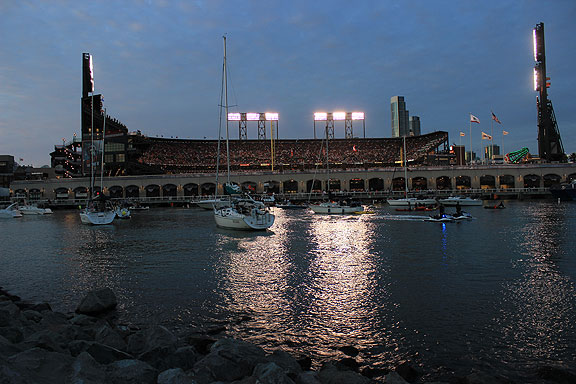 View of ballpark during Game 4 of the NLCS, Giants vs. Cardinals. What a strange day Tuesday was! The 48-year-old San Francisco Bay Guardian announced it was ceasing publication. Hardly a big surprise given how it has shrunken to a pale shadow of what it was 20 years ago, and earlier. But still, after it was absorbed into the SF Examiner + SF Weekly “empire” it seemed like it might be sustainable. I thought the editorial content got deeper and better during the past year even if the paper remained a skinny little thing. I was never a huge fan of the SFBG, but there’s no denying that it was often the only place to read about various political developments at City Hall, in the Bay Area, and even in California. For example, they published the top ten Censored Stories each year, which I never see anywhere else.
I know a lot of folks are lamenting the demise of the Bay Guardian as though some crucial institution of “progressive” San Francisco has fallen. But I always thought of the Bay Guardian as the political voice of small business. They fought tenaciously against their own typesetters who wanted to unionize back in the 1980s, claiming the unions were doing the bidding of the big newspaper monopoly (SF Chronicle + SF Examiner, and their Joint Operating Agreement). I certainly don’t doubt that the newspaper unions in that era were in a cozy relationship with the big newspaper duopoly, but the exploitative relations suffered by Bay Guardian typesetters, and freelancer writers, photographers, and illustrators, too, were reason enough to support their getting organized.
Speaking of organization, San Francisco did lose a giant of local political organizing Tuesday too, in the sudden demise of Ted Gullickson. Ted has been the guy who kept the San Francisco Tenants’ Union going for the past few decades. He was dogged and indomitable and though I was not really friends with him, I always appreciated seeing him rolling around on his bicycle, knowing that he was a key reason why we have strong rent control. He will definitely be missed.
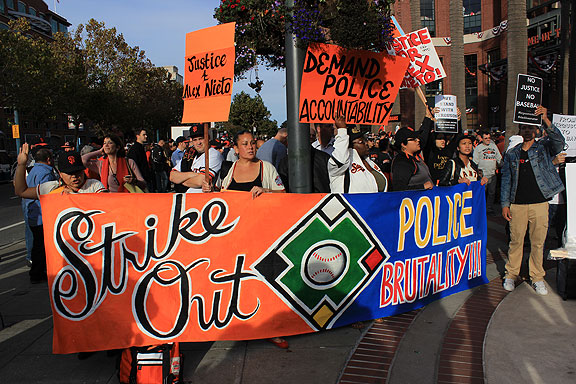 From Ferguson to San Francisco, justice for Mike Brown and Alex Nieto… great demonstration outside the playoff games at the Giants ballpark on Wednesday and Thursday. 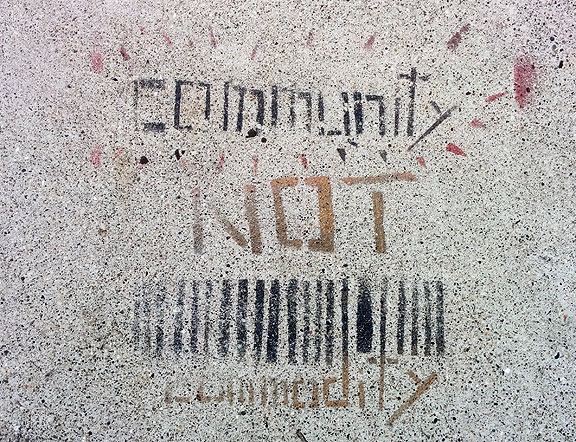 Graffiti on the ground in the City. San Francisco is melting away. Everyone who has been here for a long time can feel it, and these twin losses really bring it home to many of us. For the steady slide into a dark, pecuniary, and reactionary future, we’ll have more evidence after the coming November election. Whatever happens with local candidates for Board of Supervisors probably won’t alter anything much. The contest between centrist David Chiu and leftier David Campos for the Ammiano state legislature seat is a tight one, and I hope Campos prevails. He’s a vastly preferable candidate, honest, smart, and very capable. I’ll always remember fondly the public hearing a couple of years ago where he ripped the police department for claiming they needed the poverty-punishing “Sit-Lie” ordinance to clear the sidewalks of bad behavior when they already had a half dozen laws they weren’t enforcing. David Chiu on the other hand has proven to be a vacillating worm with no principles and an abject willingness to prostrate himself before the wealthy and influential. His latest disaster is the legalization of AirBnB rentals without recovering the $25 million in back taxes they just blew off paying. Campos attempted to amend the bill before passage to collect those taxes (for a city with a permanent fiscal crisis) but the conservatives on the Board voted it down 6-5. So much for a progressive Board!
There’s a lot to dislike on the November ballot in terms of propositions. Governor Jerry Brown and big agribusiness and other interests have placed a bond initiative on the state ballot (Prop 1) to raise $7.5 billion for water “improvements.” Some of the money will go to water recycling, gray water development, and other worthy projects. It claims it will ensure water supplies, but as a UC Davis study showed, surface water allocations have exceeded available water supplies (irrespective of the drought, which only makes it worse) by around 300 million acre-feet, the equivalent of 2.5 Lake Tahoe’s! In this bond there is apx. $2.5 billion for more surface water storage which translates into more dams in a state that has already dammed nearly every river and many more than once. More dams will NOT create more water! It will only lead to more evaporation and more riparian corridor destruction. So let’s hope this Prop 1 is defeated.
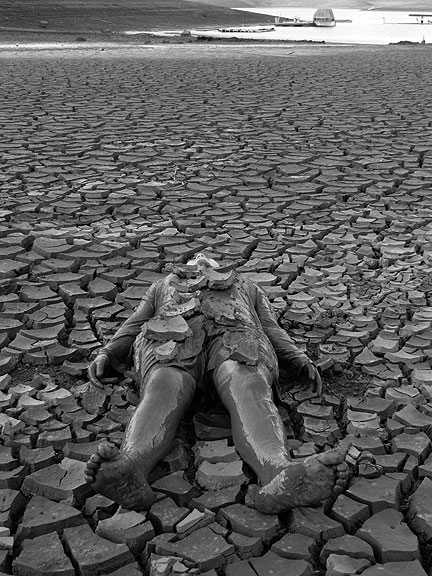 It’s getting no coverage, but the megacity Sao Paulo in Brazil is about to hit the news when it introduces severe water rationing… their largest reservoir, which supplies more than half the water to the city of over 20 million, is down to 4% of capacity due to the worst drought in recorded history there. Locally, our San Francisco ballot has a couple of litmus tests for our ever-more reactionary population. The one that gets my goat the most is Prop L, which is luckily a non-binding advisory proclamation that has the gall to call itself “Restore Transportation Balance”!!
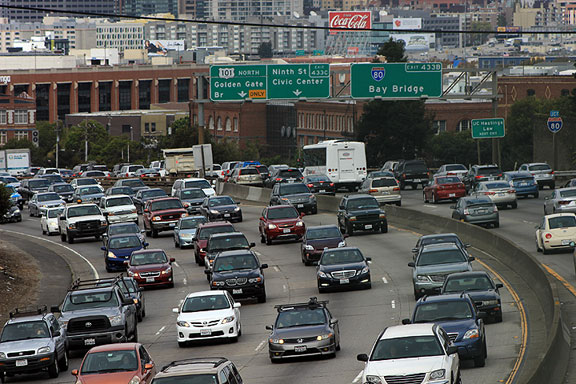 Where shall we put more cars? We’re already at 10,000 cars per square mile, more than twice Los Angeles or Houston! More than half of San Francisco is covered in asphalt. These ubiquitous roads are primarily and overwhelmingly dedicated to the housing and movement of private automobiles. The bizarre idea that there is an imbalance in transportation priorities that discriminates against cars and car owners is completely and obviously insane. Just spend a few minutes on any street in the city and find out how long you can be on foot or on a bicycle before you have to move out of the way for a motorist or someone who thinks they should be able to park their car where you are standing or walking or cycling. I’d love to “restore transportation balance” to what it was before 1920 when the horse-drawn vehicle, the cable car, the electric streetcar, and pedestrians all had more or less equal rights to the roads along with the early automobiles. Cars were expected to accommodate these other forms of transit, but in the following decades nearly all other uses were systematically discriminated against in favor of private car ownership.
The streets of the city were widened at the expense of sidewalks. Jaywalking was invented as a new crime to be regulated. And vast public expenditures were made to build roads, parking facilities, and highways, culminating in the frenzy of freeway building during the Interstate Highway period of the 1950s-1980s (a program thankfully stopped in its tracks by San Franciscans who organized to block most of the freeway plans meant to crisscross the city). Continue reading Dog-Whistle Politics in San Francisco
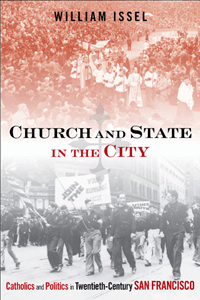
San Francisco’s much touted reputation as a bastion of liberal tolerance has an unexpected foundation in of all things, the Catholic Church! It’s a complicated tale involving the emergence of a liberal cross-class majority in favor of economic growth and individual rights that has important roots in Catholic doctrine. By the last quarter of the 20th century the same liberalism that had prevailed as a manifestation of a “vital political center” had sown the seeds of its own demise. The dominance of Catholic morality over politicians, police, business, and labor leaders began eroding under the pressure of the post-war demographic changes in San Francisco. By the time the Soviet Union finally dissolved in 1991, liberalism had already lost its defining purpose (anti-communism combined with a capitalist-friendly regime of limited labor and human rights), while in San Francisco, the liberals had long become fused with elite business interests in their pursuit of a growth economy based on white-collar finance, real estate, medicine, tourism, and technology.
William Issel does a wonderful job of revealing and analyzing this history in his 2013 book Church and State in the City: Catholics and Politics in Twentieth-Century San Francisco (Temple University Press). Rooted in the early 20th century’s labor movement, then dominated by Irish Catholics (and to a much lesser extent Italian and Latin American Catholics), “native sons” of San Francisco’s Mission District born between 1890 and 1930 played an extraordinarily influential role in the political and social development of San Francisco up to the 1970s.
In the years before the Great Depression, in the context of Vatican teachings, natural disaster, and the nation’s first red scare, Catholics challenged the presumptions of organized capital to unilaterally define the public interest. The contests involving organized business, organized labor, and the Catholic Church were then complicated by transnational rivalries, including the Communist Party’s entry into politics and its competition with Catholic Action. The city’s Catholic business, labor, and civic leaders, in complex relations with the political left and the business right, contributed to the shaping of a local New Deal liberal regime that favored expanded rights for organized labor. Organized business, Catholics, and the left, including the Communist Party, also played key roles in redefining the city’s priorities around the importance of fostering future economic growth and human rights. (Issel, p. 251)
Many histories of San Francisco tend to focus on the ebb and flow of class conflict between the city’s business-owning elite and the various unions, confederations, and labor parties that emerged in different periods, a conflict that featured social unrest and upheavals from the 1870s through the dramatic General Strike in 1934 and into the post-WWII era, punctuated by only a few periods of sustained social peace. In this fraught dynamic, Father Peter Yorke held forth at the Mission’s St. Peter’s Church on 24th Street at the beginning of the 20th century. He was an outspoken advocate of the rights of the working man (who were largely identified as white ethnic Irish) along with his ardent support for Irish nationalism vis-a-vis the British empire. Yorke was but one of many Catholic men and women who sought to influence the terms of debate about the common good and what public policy would look like in the early 20th century and ensuing decades. Catholics enjoyed a disproportionate role in the political life of San Francisco due to being nearly a third of the population before WWII, but the politics of the Church (run by the Archdiocese with offices on Franklin Street) were not uniformly conservative. Continue reading Liberal San Francisco and the Catholic Church
 From a trail on the Marin Headlands looking back towards San Francisco from under an amazing oak tree… It’s been a summer of reading (and walking, see photos!) for me, and now that autumn is here and the usual schedule of Shaping San Francisco Tours and Talks is starting, along with teaching weekly at the Art Institute, my time is shrinking. I still have a lot of time compared to most people so I’m not complaining (and I’m still reading a lot, but less). Anyway, this blog post is less of my writing and more from one of the books I read, which is a must-read for anyone still harboring fantasies that Fidel Castro is a great revolutionary.
I say this knowing that many people, even a fair number of friends, are ardent defenders of Castro, of the Cuban Revolution (which they unfortunately conflate), and the many movements that have claimed Castro as an inspiration or icon for their own efforts at “national liberation” (whether Chavez’s Bolivarian revolution in Venezuela, or the FMLN in El Salvador or the Sandinistas in Nicaragua). I am not attacking the people in these various places, not in Cuba or anywhere else, since it’s the rank and file activists who ultimately are the most betrayed by authoritarian party structures created by the various left-wing organizations in the name of revolution. Frequently, starting with Cuba, the argument is made that the United States directly or indirectly has forced these movements to become rigid top-down hierarchies, to center their organizations on a military logic, and to slavishly copy the worst of the old Soviet Union or Chinese Communist Party which in practical terms meant the brutal repression of all liberatory currents not under their tight control (in addition to the more obvious reactionary social groups that also exist in these countries).
 Gerbode Valley from just north of the Golden Gate… I also read a longer book called The Return of Comrade Ricardo Flores Magón by Claudio Lomnitz, which is a beautifully composed look at the forgotten role of the Partido Liberal Mexicana (PLM) from 1906 to the eventual revolution overthrowing decades-long dictator Porfirio Díaz, with a detailed account of how its original leading role was marginalized by other leaders and groups in Mexico in part because the PLM leaders chose to stay in Los Angeles to carry on their publishing beyond the reach of the Mexican authorities. Lomnitz does a great job of capturing the cross-border ferment between the U.S. and Mexico, where the revolutionaries grouped together in the PLM organized and published their journal Regeneración. Moving around in the U.S. the Mexican revolutionaries worked closely with a growing group of U.S. radicals, including Wobblies and famed Los Angeles attorney and socialist Job Harriman. Ricardo Flores Magón was the chief theoretician of the self-proclaimed Junta, along with his brother Enrique Flores Magón. Antonio I. Villarreal, Librado Rivera, and Lázaro Gutiérrez de Lara, but others played important roles too, notably various American radicals such as William Owen, Elizabeth Trowbridge and John Kenneth Turner (author of the 1907 blockbuster Barbarous Mexico which in classic muckraking journalism exposed widespread slavery in the Yucatan and Oaxaca). Continue reading Revolutionaries Who Fall Short
|
Hidden San Francisco 2nd EDITION!

NEW 2nd EDITION NOW AVAILABLE!
Buy one here
(Pluto Press, Spring 2025)
|



















